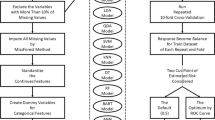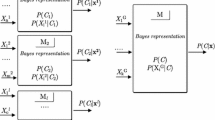Abstract
Medical applications on cardiovascular disease (CVD) for hybrid computing models are an emerging research area. The CVD, including stroke, hypertension, and high cholesterol, is one of 10 leading causes of death in Taiwan in middle-aged and elderly; in particular, the CVD has become the top killer in advanced countries. Thus, this serious but interesting issue triggers the study to focus on patients of the CVD. The study explores variables, influencing cardiovascular functions for four risk factors of blood pressure, blood glucose, blood fat, and kidney diseases, in the middle-aged and elderly. By the data collection of regular physical examination system from a regional hospital, the original dataset contains 52 variables collected from October 2011 to February 2014. We model a hybrid knowledge-based classification system to organize expert experiences, integrated linear and nonlinear attribute selection methods, data discretization of smart expert method, rough set theory, the LEM2 algorithm, and rule-filtering technique to classify the CVD for the early warning purpose. After data cleaning, 20 attributes with 2027 records are remained. For effectively identifying the variables of CVD subjects, this study reclassifies the above four risk diseases into three classes: no disease, 1&2 diseases, and 3&4 diseases. To verify performance of the proposed procedure, we experience an empirical experiment to compare the full 20 used attributes, the used attributes of integrated linear and nonlinear attribute selections with rule-filtering technique, and various classifiers. Conclusively, the 13 used attributes obtained from optimal accuracy become the key determinants that affect the four risk factors of the CVD. The empirical results and findings benefit doctors’ and medical institutions’ early medical recommendations and treatments with the advantages of significantly reducing morbidity of CVD.

Similar content being viewed by others
References
Akchurin OM, Kaskel F (2015) Update on inflammation in chronic kidney disease. Blood Purif 39(1–3):84–92
Al-Obeidat F, El-Alfy ESM (2017) Hybrid multicriteria fuzzy classification of network traffic patterns, anomalies, and protocols. Pers Ubiquit Comput:1–15. https://doi.org/10.1007/s00779-017-1096-z
American Medical Association (2001) Executive summary of the third report of The National Cholesterol Education Program (NCEP) Expert Panel on Detection, Evaluation, and Treatment of High Blood Cholesterol in Adults (Adult Treatment Panel III). JAMA 285(19):2486–2497
Arbel Y, Halkin A, Finkelstein A, Revivo M, Berliner S, Herz I (2013) Impact of estimated glomerular filtration rate on vascular disease extent and adverse cardiovascular events in patients without chronic kidney disease. Can J Cardiol 29(11):1374–1381
Auria L, Moro RA (2008) Support vector machines (SVM) as a technique for solvency analysis. DIW Berlin Discussion Paper No. 811, German Institute for Economic Research, Berlin, Germany 1–16
Benfante R, Reed D, Frank J (1992) Do coronary heart disease risk factors measured in the elderly have the same predictive roles as in the middle aged comparisons of relative and attributable risks. Ann Epidemiol 2(3):273–282
Beun RJ, Anderson J, Ham Klein MJ, Roefs A, Westerink J (2017) Special issue on supporting a healthier lifestyle with e-coaching systems. Pers Ubiquit Comput 21(4):621–623
Blum AL, Langley P (1997) Selection of relevant features and examples in machine learning. Artif Intel 97(1–2):245–271
Briggen PM, Blocken B, Schellen HL (2009) Wind-driven rain on the facade of a monumental tower: numerical simulation, full-scale validation and sensitivity analysis. Build Environ 144:1675–1690
Burges CJC (1998) A tutorial on support vector machines for pattern recognition. Data Min Knowl Discov 2(2):121–167
Cheng CH, Chen YS (2009) Classifying the segmentation of customer value via RFM model and RS theory. Expert Syst Appl 36:4176–4184
Chou HC, Cheng CH, Chang JR (2007) Extracting drug utilization knowledge using self-organizing map and rough set theory. Expert Syst Appl 33:499–508
Cortes C, Vapnik V (1995) Support-vector networks. Mach Learn 20(3):273–297
Damrongrit S, Theera P, Waranyu W, Touchpong U, Nuttawut P, Chompunut K, Monchan S, Chanin L, Nachol C (2011) Classification of complete blood count and haemoglobin typing data by a C4.5 decision tree, a naïve Bayes classifier and a multilayer perceptron for thalassaemia screening. Biomed Signal Proces 7:202–212
Danjuma K, Osofisan A (2015) Evaluation of predictive data mining algorithm in erythemato-squamous diagnosis. Int J Comput Sci Iss 11(6):85–94
Dash M, Choi K, Scheuermann P, Liu H (2002) Feature selection for clustering—a filter solution. Proceedings 2002 IEEE International Conference on Data Mining 115–122
Dimitras AI, Slowinski R, Susmaga R, Zopounidis C (1999) Business failure prediction using rough sets. Eur J Oper Res 114:263–280
Elhaj FA, Salim N, Harris AR, Swee TT, Ahmed T (2016) Arrhythmia recognition and classification using combined linear and nonlinear features of ECG signals. Comput Methods Prog Biomed 127:52–63
Fuster V, Kelly BB (2010) Promoting cardiovascular health in the developing world: a critical challenge to achieve global health. Editors in Washington, D.C.: National Academies Press
Ghadi M, Laouamer L, Nana L, Pascu A (2018) Rough set theory based on robust image watermarking. In: Hassanien A, Oliva D (eds) Advances in soft computing and machine learning in image processing, Stu Comput Intell, vol 730, pp 627–659
Grzymala-Busse JW (1997) A new version of the rule induction system LERS. Fund Inform 31(1):27–39
Grzymala-Busse JW (1992) LERS—a system for learning from examples based on rough sets. In: Słowiński R (eds) Intelligent decision support: hand-book of applications and advances of the rough sets theory. Springer, Dordrecht: Kluwer Academic Publishers, p 3–18
Jones DE, Ghandehari H, Facelli JC (2016) A review of the applications of data mining and machine learning for the prediction of biomedical properties of nanoparticles. Comput Methods Prog Biomed 132:93–103
Kandhasamy JP, Balamurali S (2015) Performance analysis of classifier models to predict diabetes mellitus. Proce Compu Sci 47:45–51
Khorshidtalab A, Salami MJE, Akmeliawati R (2017) Motor imagery task classification using transformation based features. Biomed Signal Proces 33:213–219
Kim TJ, Kim CK, Kim BG (2018) An efficient hybrid delivery technology for a broadcast TV service. Pers Ubiquit Comput 22(1):135–141. https://doi.org/10.1007/s00779-017-1059-4
Lamon-Fava S, Wilson PW, Schaefer EJ (1996) Impact of body mass index on coronary heart disease risk factors in men and women. Arterioscler Thromb Vasc Biol 16(12):1509–1515
Liu H, Yu L (2005) Toward integrating feature selection algorithms for classification and clustering. IEEE T Knowl Data Eng 17(4):491–502
Mathers CD, Loncar D (2006) Projections of global mortality and burden of disease from 2002 to 2030. PLoS Med 3(11):e442. https://doi.org/10.1371/journal.pmed.0030442
Mehmood R, El-Ashram S, Bie R, Sun Y (2017) Effective cancer subtyping by employing density peaks clustering by using gene expression microarray. Pers Ubiquit Comput 22:1–5. https://doi.org/10.1007/s00779-018-1112-y
Ministry of Health and Welfare, Taiwan (MHWT, 2017) http://www.mohw.gov.tw Accessed 20 November 2017
Mitra P, Murthy CA, Pal SK (2002) Unsupervised feature selection using feature similarity. IEEE Trans Pattern Anal Mach Intell 24(3):301–312
Nabel EG (2003) Cardiovascular disease. New Engl J Med 349(1):60–72
Nelson B, Kouh JS (2016) The numerical analysis of wind turbine airfoils at high angles of attack. Int J Energ Environ Eng 7(1):1–12
Pardo PJ, Georfopoulos AP, Kenny JT, Stuve TA, Findling RL, Schulz SC (2006) Classification of adolescent psychotic disorders using linear discriminant analysis. Schizophr Res 87:297–306
Pawlak Z (1982) Rough sets. Int J Comput Inform Sci 11(5):341–356
Pawlak Z (1991) Imprecise categories, approximations and rough sets. In: Rough sets. Theory and Decision Library (Series D: System Theory, Knowledge Engineering and Problem Solving), Vol. 9. Springer, Dordrecht, Netherlands, 9–32
Pawlak Z (1997) Rough set approach to knowledge-based decision support. Eur J Oper Res 99:48–57
Pirbhulal S, Zhang H, Mukhopadhyay SC, Li C, Wang Y, Li G, Wu W, Zhang YT (2015) An efficient biometric-based algorithm using heart rate variability for securing body sensor networks. Sens 15(7):15067–15089
Pirbhulal S, Zhang H, Wu W (2017) HRV-based biometric privacy-preserving and security mechanism for wireless body sensor networks. In: Subhas Chandra Mukhopadhyay & Tarikul Islam, Wearable sensors: applications, design and implementation, IOP Publishing, Bristol, UK, Chapter 12:1–25
Rosendorff C, Black HR, Cannon CP, Gersh BJ, Gore J, Izzo JL, Oparil S et al (2007) REPRINT treatment of hypertension in the prevention and management of ischemic heart disease: a scientific statement from the American Heart Association Council for high blood pressure research and the councils on clinical cardiology and epidemiology and prevention. Hypertens 50(2):e28–e55
Saeed M, Mehran M, Hossein A, Rezvan N, Yones N (2009) Application of multilayer perceptron and radial basis function neural networks in differentiating between chronic obstructive pulmonary and congestive heart failure diseases. Expert Syst Appl 36:6956–6959
Sodhro AH, Fortino G (2017) Energy management during video transmission in wireless body sensor networks. In: 14th IEEE International Conference on Networking, Sensing and Control (ICNSC), Calabria, Southern Italy, May 16–18 2017
Sudha M, Kumaravel A (2018) Quality of classification with LERS system in the data size context. Appl Comput Inform. https://doi.org/10.1016/j.aci.2018.02.001
Teoh HJ, Cheng CH, Chu HH, Chen JS (2008) Fuzzy time series model based on probabilistic approach and rough set rule induction for empirical research in stock markets. Data Knowl Eng 67(1):103–117
Tsai HC, Tseng WP, Yen TS (1967) Coronary heart disease and hypertension in Taiwan aborigines. Am J Epidemiol 86:253–263
Tsumoto S (1998) Automated extraction of medical expert system rules from clinical databases based on rough set theory. Inf Sci 112:67–84
Warsaw University (2005) RSES 2.2 user’s guide. http://logic.mimuw.edu.pl/wrses/RSES_doc_eng.pdf Accessed 08 January 2018
White WB, Kupfer S, Zannad F, Mehta CR, Wilson CA, Lei L, Bergenstal RM (2016) Cardiovascular mortality in patients with type 2 diabetes and recent acute coronary syndromes from the EXAMINE trial. Diabetes Care 39(7):1267–1273
Wu W, Zhang H, Pirbhulal S, Mukhopadhyay SC, Zhang Y-T (2015) Assessment of biofeedback training for emotion management through wearable textile physiological monitoring system. IEEE Sensors J 15(12):7087–7095
Xiao X, Pirbhulal S, Dong K, Wu W, Mei X (2017) Performance evaluation of plain weave and honeycomb weave electrodes for human ECG monitoring. J Sens 2017(7539840):1–14
Xue Y, Zhang X, Li S, Qiu D, Su M, Li L, Li Z, Tao Y (2018) Analysis of factors influencing tunnel deformation in loess deposits by data mining: a deformation prediction model. Eng Geol 232:94–103
Zhang J, Zhou Z, Li S, Gan L, Zhang X, Qi L, Xu X, Dou W (2018) Hybrid computation offloading for smart home automation in mobile cloud computing. Pers Ubiquit Comput 22(1):121–134
Acknowledgments
We especially appreciate the Chief Editor and Managing Editor as well as the anonymous referees for their useful suggestions to improve the quality of this paper.
Funding
The authors wish to cordially thank the Ministry of Science and Technology, Taiwan ROC, for partially financially supporting this research under Grant Nos. MOST 105-2410-H-146-002 and 106-2221-E-146-005.
Author information
Authors and Affiliations
Corresponding author
Ethics declarations
Conflict of interest
The authors declare that they have no conflicts of interest.
Rights and permissions
About this article
Cite this article
Cheng, CH., Chen, YS., Sangaiah, A.K. et al. Evidence-based personal applications of medical computing models in risk factors of cardiovascular disease for the middle-aged and elderly. Pers Ubiquit Comput 22, 921–936 (2018). https://doi.org/10.1007/s00779-018-1172-z
Received:
Accepted:
Published:
Issue Date:
DOI: https://doi.org/10.1007/s00779-018-1172-z




